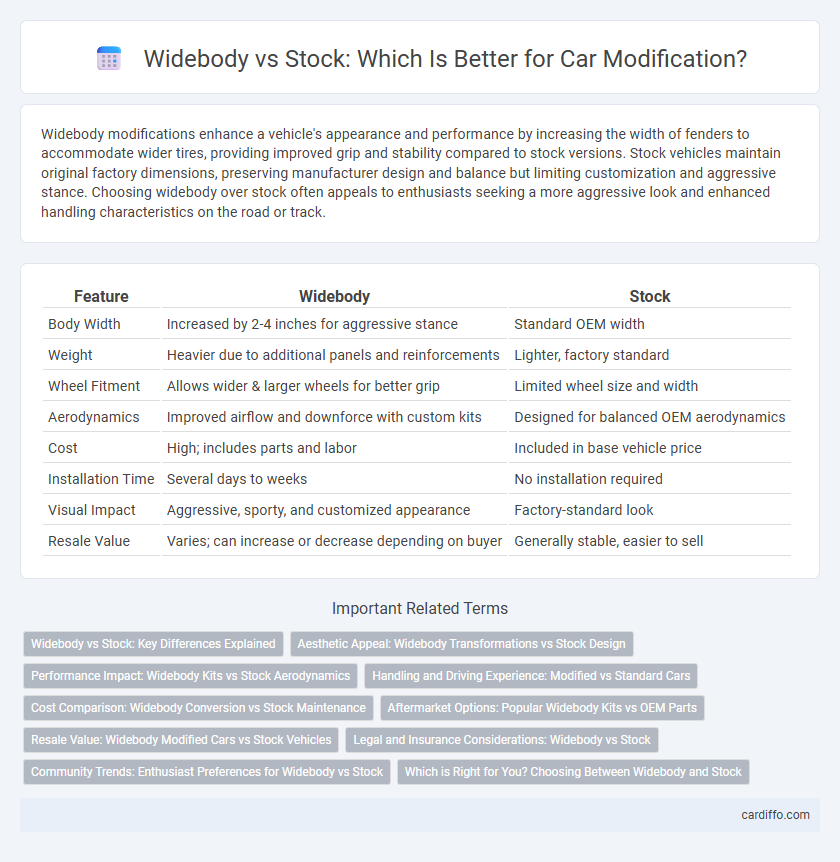Widebody modifications enhance a vehicle's appearance and performance by increasing the width of fenders to accommodate wider tires, providing improved grip and stability compared to stock versions. Stock vehicles maintain original factory dimensions, preserving manufacturer design and balance but limiting customization and aggressive stance. Choosing widebody over stock often appeals to enthusiasts seeking a more aggressive look and enhanced handling characteristics on the road or track.
Table of Comparison
| Feature | Widebody | Stock |
|---|---|---|
| Body Width | Increased by 2-4 inches for aggressive stance | Standard OEM width |
| Weight | Heavier due to additional panels and reinforcements | Lighter, factory standard |
| Wheel Fitment | Allows wider & larger wheels for better grip | Limited wheel size and width |
| Aerodynamics | Improved airflow and downforce with custom kits | Designed for balanced OEM aerodynamics |
| Cost | High; includes parts and labor | Included in base vehicle price |
| Installation Time | Several days to weeks | No installation required |
| Visual Impact | Aggressive, sporty, and customized appearance | Factory-standard look |
| Resale Value | Varies; can increase or decrease depending on buyer | Generally stable, easier to sell |
Widebody vs Stock: Key Differences Explained
Widebody kits modify the stock vehicle by extending the fenders to accommodate wider tires, enhancing both aesthetics and handling performance. Stock vehicles retain their original factory dimensions, limiting tire width and reducing potential grip on the road or track. Widebody conversions improve aerodynamics and stability, making them popular upgrades for performance enthusiasts.
Aesthetic Appeal: Widebody Transformations vs Stock Design
Widebody transformations significantly enhance a vehicle's aesthetic appeal by adding aggressive wheel arches and a broader stance, which accentuates the car's sporty and muscular look compared to the more restrained stock design. The expanded fenders and lower profile improve visual dynamics, making the vehicle appear more performance-oriented and unique. Stock designs maintain factory proportions and a cleaner look, appealing to those who prefer subtlety and original manufacturer styling.
Performance Impact: Widebody Kits vs Stock Aerodynamics
Widebody kits significantly alter a vehicle's aerodynamics by increasing the surface area and modifying airflow, which can enhance stability at high speeds and improve cornering performance through better downforce distribution. Stock aerodynamics are typically optimized for a balance between fuel efficiency and standard driving conditions but may lack the aggressive airflow management required for competitive performance. The added drag from widebody extensions can reduce top speed but often results in superior handling and traction, making them ideal for track use and high-performance driving scenarios.
Handling and Driving Experience: Modified vs Standard Cars
Widebody modifications improve handling by increasing tire width and enhancing grip, resulting in sharper cornering and greater stability compared to stock cars. The wider track reduces body roll and enhances responsiveness, providing a more engaging and confident driving experience. Standard cars offer balanced performance with predictable handling, but lack the aggressive dynamics and enhanced road feedback that widebody setups deliver.
Cost Comparison: Widebody Conversion vs Stock Maintenance
Widebody conversions typically cost several thousand dollars more than maintaining a stock vehicle due to the extensive body panel replacements, custom fabrication, and specialized labor involved. Stock maintenance expenses are generally limited to routine repairs and OEM part replacements, which are significantly less costly than the materials and labor needed for widebody kits. Budget considerations should include not only initial modification expenses but also potential increases in insurance premiums and long-term upkeep related to the unique widebody components.
Aftermarket Options: Popular Widebody Kits vs OEM Parts
Popular widebody kits like Rocket Bunny, Liberty Walk, and APR Performance offer aggressive styling and increased fender clearance for larger wheels, enhancing both aesthetics and handling. OEM parts, while more expensive and limited in design variation, provide exact fitment and maintain factory-quality finishes, ensuring durability and resale value. Aftermarket widebody kits emphasize customization and weight reduction, whereas OEM parts prioritize vehicle integrity and warranty compatibility.
Resale Value: Widebody Modified Cars vs Stock Vehicles
Widebody modified cars often experience a variable impact on resale value, depending on the quality of the modification and buyer preferences, with some enthusiasts willing to pay a premium for unique aesthetics and improved performance. Stock vehicles tend to maintain more stable resale values due to broader market appeal and manufacturer warranty retention. Market trends show that extreme widebody modifications may limit potential buyers, while subtle enhancements can positively influence resale if documentation and build quality are well-maintained.
Legal and Insurance Considerations: Widebody vs Stock
Widebody modifications often require thorough inspection and approval to comply with local vehicle regulations, impacting legal roadworthiness. Insurance providers may increase premiums or impose coverage restrictions due to altered vehicle dimensions and potential safety concerns. Maintaining thorough documentation and notifying insurers of widebody modifications helps ensure compliance and optimal policy terms compared to stock configurations.
Community Trends: Enthusiast Preferences for Widebody vs Stock
Enthusiast preferences in the modification community reveal a growing trend toward widebody kits due to their aggressive aesthetics and enhanced performance capabilities. Stock configurations remain popular for purists valuing originality and factory tuning, but widebody conversions dominate social media platforms and car meets for their unique customization potential. Data from forums and automotive shows indicate a significant increase in widebody projects, reflecting a cultural shift toward bold, personalized vehicle modifications.
Which is Right for You? Choosing Between Widebody and Stock
Choosing between a widebody and stock modification depends on your goals for performance, aesthetics, and budget. Widebody kits offer enhanced aerodynamics and aggressive styling, ideal for track enthusiasts or those seeking a unique look, while stock configurations maintain factory reliability and simplicity. Assess your driving needs and long-term plans to determine which option delivers the best value and functionality for your vehicle.
widebody vs stock Infographic

 cardiffo.com
cardiffo.com